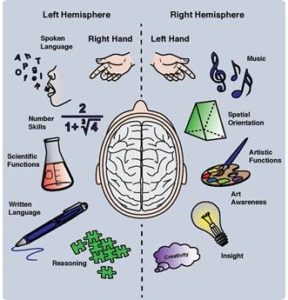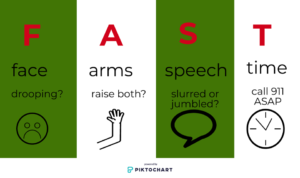A stroke occurs when blood flow is disrupted to any portion of the brain. This causes damage to the brain cells because they need a constant supply of blood for oxygen and nourishment. A stroke can occur at any age and they affect women more than men. Women have a higher risk of stroke during pregnancy, during menopause and at an older age.
There are three types of strokes:
Ischemic stroke – blockage or clot in the blood vessel in your brain
Hemorrhagic stroke – an artery in the brain breaks open
Transient ischemic attack (TIA) – small clot that briefly blocks an artery. A TIA usually lasts less than an hour. It is also called a mini-stroke and is an important warning sign to see a doctor immediately.
The damage that occurs is dependent on where in the brain the stroke happened. The brain is broken up into two hemispheres. The picture below shows brain activities and which half of the brain they are controlled by.

The severity of a stroke is determined by: type of stroke, side/lobes of brain affected, size of damaged area, amount of time blood flow was interrupted and the length of time it took to get to the hospital.
The acronym FAST is used to remember the symptoms of a stroke:

Less common symptoms of a stroke include:
- vision changes (e.g. blurry or double vision)
- sudden severe headache
- numbness (generally one-sided)
- balance issues
There are medical conditions that are considered risk factors for stroke. These include: high blood pressure, high cholesterol, diabetes and atrial fibrillation.
There are lifestyle choices that also increase the risk for a stroke. These include: unhealthy diet, lack of exercise, overweight, smoking, stress, alcohol abuse and drug abuse.
A stroke is a medical emergency, seek medical attention immediately.
